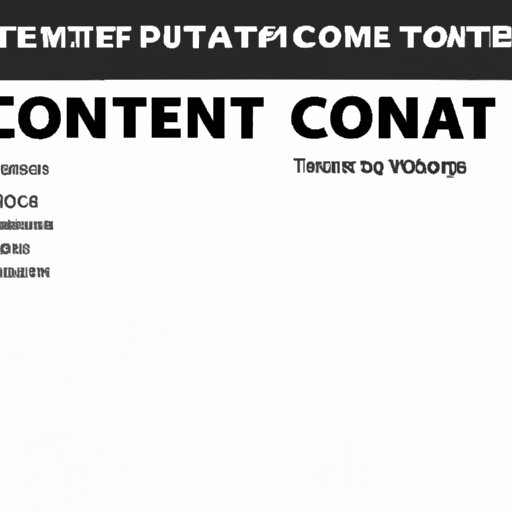
I. Introduction
When it comes to formatting documents, creating a table of contents is essential for navigating through lengthy content. In this article, we will guide you through creating a table of contents in Word using different methods. Whether you are a student, a researcher, or a writer, you will need to create a table of contents to help your readers find specific information quickly.
II. Step-by-step guide
A table of contents is a list of all the headings and subheadings in a document, along with their corresponding page numbers. Follow these steps to create a table of contents in Word:
Step 1: Organize your headings into levels
Step 2: Insert a blank page where you want your table of contents to appear
Step 3: Click on “References” in the top menu bar
Step 4: Click on “Table of Contents”
Step 5: Choose the format of your table of contents
Step 6: Your table of contents will appear based on the headings and subheadings in your document
Step 7: Update your table of contents to reflect any changes or edits made to your document
III. Video tutorial
If you prefer a visual tutorial, you can watch this video for step-by-step instructions on creating a table of contents in Word.
In summary, you will need to organize your headings and subheadings, choose the format of your table of contents, and update it accordingly.
IV. List of tips and tricks
Here are a few tips to help you create an effective table of contents:
Formatting:
– Be consistent with your headings and subheadings formatting
– Use headings and subheadings that are clear and descriptive
– Avoid using more than three levels of headings
Customization:
– Include only the headings and subheadings that you want to appear in your table of contents
– Use different styles or numbering for different levels of headings
– Customize the appearance of your table of contents to match your document style
V. Comparison article
There are various options for creating a table of contents in Word, such as using styles or the automatic table of contents feature. Each option has its pros and cons, depending on your formatting needs. Check out our article on comparing different methods for creating a table of contents in Word to decide which option works best for you.
VI. Using templates
Using pre-built templates can save you time and effort when creating a table of contents. Within Word, you can find numerous templates that you can customize to fit your specific needs. Check out our article on how to use templates to create a table of contents in Word.
VII. Conclusion
Creating a table of contents is a crucial step in formatting your document. Whether you choose to use styles, automatic table of contents, or templates, ensure that your table of contents is clear and easy to follow. With these tips and tricks, you can create a professional-looking table of contents in no time. If you have any questions or concerns, don’t hesitate to reach out to Word’s support team.





